“Regeneration”
Written by Mike Sussman & Phyllis Strong
Directed by David Livingston
Season 2, Episode 23
Production episode 049
Original air date: May 7, 2003
Date: March 1, 2153
Captain’s star log. An expedition in the Arctic on Earth has found some technological remains and a couple of bodies that appear to have been in the ice for about a hundred years. They are unfamiliar to the scientists, but instantly recognizable to the viewer as Borg—likely left over from the sphere that went back in time to 2063 from 2373.
The Borg soon wake up and assimilate the trio of scientists, then they take the team’s transport and upgrade it so it can travel at much greater speeds than before and it heads out into space. By the time Starfleet investigates the lack of contact, they’re long gone.
Buy the Book
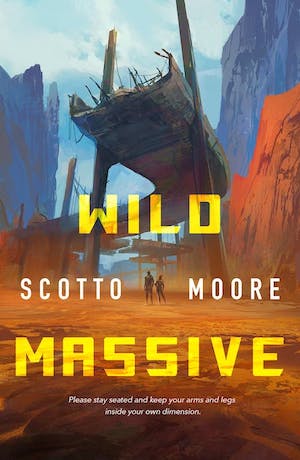

Wild Massive
The transport’s course puts it within six light-years of Enterprise’s position, so Forrest contacts Archer and sends them after the ship.
A Tarkalean freighter sends out a distress call, and Enterprise diverts to respond. The freighter is being attacked by the transport. Enterprise fires on the transport, and it buggers off, but Enterprise can’t give chase right away, as the freighter is dead in space, with significant damage, and two survivors. The latter are taken to sickbay, where Phlox discovers tons of nanoprobes in their bloodstream that are multiplying at a great rate. Phlox wrongly assumes that there’s no danger to the crew.
As Enterprise resumes its chase of the transport, Archer tells T’Pol about a speech Zefram Cochrane gave at Princeton once where he mentioned cybernetic creatures from the future who tried to stop the Phoenix warp flight. He later disavowed that speech—and, T’Pol reminds him, Cochrane had a reputation for exaggeration and for being a drunk—but given the timing, Archer is starting to wonder…
The two Tarkaelans Borg out, inject Phlox with nanoprobes, and subdue the guard Reed left on duty before escaping sickbay. Reed and his people start searching for the two Borg, finding altered computer terminals, and eventually the two altered Tarkaleans. Phase pistols have no effect on them; the best Reed can do is club one over the head with the butt of his pistol. Archer is forced to blow them out into space by opening an airlock.
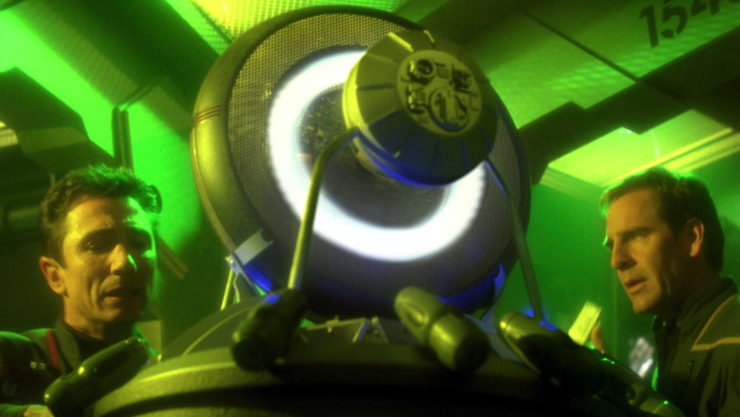
The transport is now going at almost warp five—it was designed to originally go at warp 1.4 (why a transport used for a terrestrial expedition had faster-than-light capability is left as an exercise for the viewer). Enterprise gets into a firefight with it, and is losing. Archer and Reed risk using the transporter to beam over and plant explosives. That disables the ship long enough for Enterprise to target the ship’s warp core and blow it up.
Denobulan immune systems are more resistant to the nanoprobes than human or Tarkalean ones, and Phlox hypothesizes that omicron radiation might wipe out the nanoprobes, if it doesn’t kill him. If it fails and he’s assimilated, he gives Archer a neurotoxin to inject in him. But, since he’s in the opening credits, it works just fine.
Sato reports that a signal went out from the transport toward the Delta Quadrant before it was destroyed.
Can’t we just reverse the polarity? Omicron radiation can apparently neutralize Borg nanoprobes, something Phlox figured out in 2153 and which nobody in the twenty-fourth century ever cottoned to, apparently.
The gazelle speech. Archer is devastated at having to space the Tarkaleans, and right up until the end he tries to rescue the three scientists.
Florida Man. Florida Man Boggled By Unusually Fast Transport.
Optimism, Captain! Phlox takes a heartbreakingly clinical approach to his own treatment after being infected with the nanoprobes, refusing food for fear it will speed up his cellular metabolism and therefore help the nanoprobes spread further, and calmly providing Archer with a neurotoxin as a last resort.
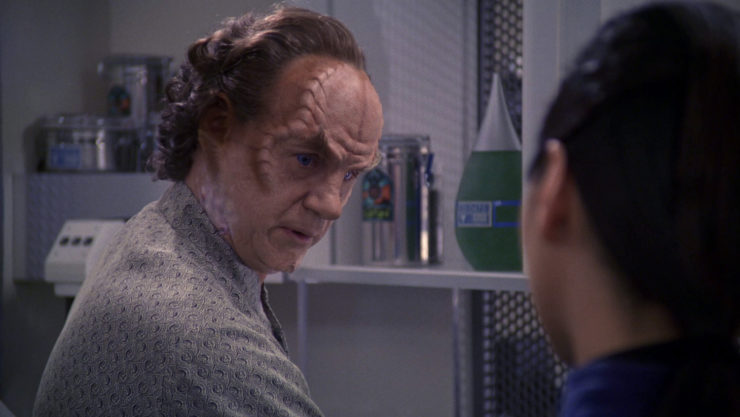
More on this later. T’Pol informs Archer that the signal the transport sent will reach the Delta Quadrant in two hundred years—or, right when the Federation has its encounters with the Borg. What a coinky-dink!
Reed jokes about firing holographic bullets at the Borg drones; in First Contact, Picard killed several drones with a holodeck-created Tommy gun.
I’ve got faith…
“You seem a little jumpy.”
“Cybernetic corpses, digging through frozen remains in the middle of the night—why would I be jumpy?”
–Two of the researchers bantering.
Welcome aboard. The three researchers are played by Bonita Friedericy, John Short, and Chris Wynne. Friedericy—probably best known for her role as General Beckman on Chuck—is the wife of John Billingsley, who had been trying to get her cast on the show for two years, though his hope was that she would be cast as one of Phlox’s wives.
Also here are recurring regulars Vaughn Armstrong as Forrest and Jim Fitzpatrick as Williams.
Trivial matters: This is obviously a sequel to the movie First Contact, with the remains found in the Arctic from the Borg sphere that the Enterprise-E blew up in orbit of Earth in 2063. It’s also a prequel to pretty much every other Borg story…
Bonita Friedericy joked in the audio commentary on the season two Blu-Ray of Enterprise that she got cast in this episode by sleeping with Connor Trinneer. More seriously, she said she was unnerved by Rick Berman and Brannon Braga pretending not to know her when she came in to audition, but they didn’t want to be seen to be playing favorites.
Phlox mentions the Bynars, a species introduced in TNG’s “11001001” (and also seen regularly in the Starfleet Corps of Engineers series of prose stories edited by your humble rewatcher).
This is the only onscreen appearance of the Tarkaleans, previously mentioned several times, mostly in relation to their tea…
This episode is the catalyst for the storyline in the Star Trek Legacy videogame, in which a Vulcan scientist examines the debris from the Borg ship.
This is the only appearance of the Borg on Enterprise. As of this writing, the Borg have appeared in seven of the eleven Trek TV series (multiple episodes of TNG, Voyager, and Picard, DS9’s “Emissary,” this episode of Enterprise, LD’s “I, Excretus,” and Prodigy’s “Let Sleeping Borg Lie”).
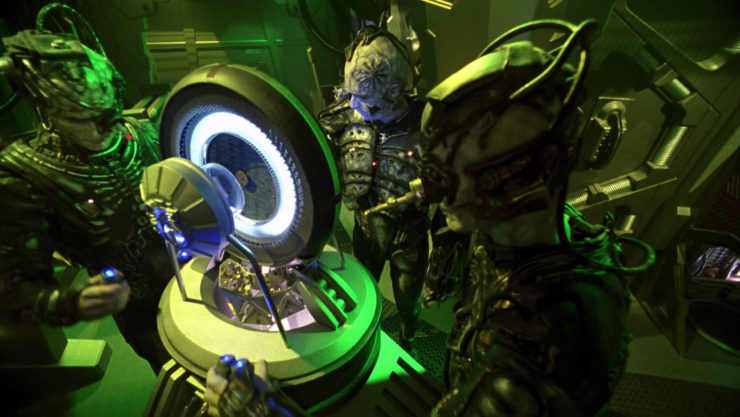
It’s been a long road… “What sort of people would replace perfectly good body parts with cybernetic implants?” When this episode first was announced, my response—and the response of many Trek fans—was a rolling of the eyes. In much the same way “Acquisition” seemed an unnecessary foray into continuity landmines just for the sake of doing a Ferengi episode, so too here with the Borg.
However, this is both a better episode than “Acquisition,” and also less of a risk, for several reasons. For one thing, the Borg are way more popular than the Ferengi. For another, in this case, the continuity hit was already there. After all, even a big-ass explosion is going to leave some debris, and it makes perfect sense that some bits of the Borg sphere might land on Earth. And landing in the Arctic is a particular masterstroke, since the shifting ice floes up there are such that it’s easy enough for things to disappear from sight for long periods of time.
In addition, this episode is a much more compelling viewing experience, as they sensibly gave what is mostly an action-adventure story to David Livingston to direct. Livingston’s resumé includes several of Trek’s best action stories (TNG’s “Power Play,” DS9’s “The Die is Cast,” Voyager’s “Hunters”).
I especially like that they took the time to establish the research team, giving us a teaser that actually teased the episode and then spending the entire first act on their digging around in the Arctic. Some really nice Thing From Another World vibes in that opening, which was lotsa fun.
Having said all that—I got to the end of the episode with a big feeling of “so what?” I mean, it was a cute little continuity hit, but it wasn’t much of one, since—just as with “Accquisition”—Archer and the gang had to come away with very little information and not very badly affected by the Borg. In particular, I was annoyed with Phlox being infected with nanoprobes, as that created the only real continuity issue: a twenty-second-century Denobulan physician comes up with a way to neutralize Borg nanoprobes, which has somehow never been thought of by anyone else—including, to give one example, the Emergency Medical Hologram on Voyager that had all the medical knowledge of the Alpha Quadrant programmed into his brain—in the two-and-a-half centuries since.
And, ultimately, there isn’t really a plot here. Aside from a really nice scene between Sato and Phlox when the former brings the latter food for both his animals and himself, there’s no real character stuff here, and our heroes don’t really accomplish much, and it just feels incredibly inconsequential. Yes, it sets up the future Borg stories, but those stories were already set up just fine, thanks—in particular, it was Q’s actions in TNG’s “Q Who” that put the Federation on the Borg’s sensor screen, so it wasn’t really necessary to provide this extra bit.
Still, it’s a good action story, at least…
Warp factor rating: 6
Keith R.A. DeCandido has a short story in the newly released anthology The Eye of Argon and the Further Adventures of Grignr the Barbarian, edited by Michael A. Ventrella. It includes the original (and annotated) text of the famously terrible fantasy novella, as well as several sequel stories, including Keith’s “The Rat’s Tail.” It’s available from Fantastic Books.




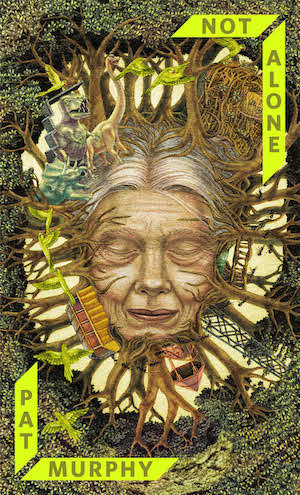





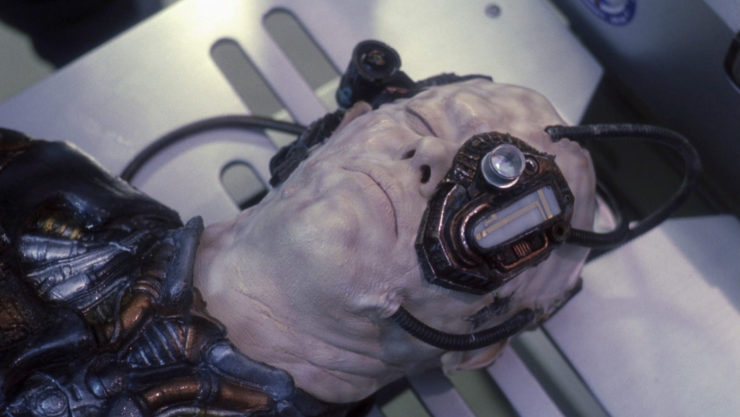
I agree with Krad’s assessment: unnecessary but still a fun, action-packed 40+ minutes. I also agree it was a good set-up having so much time spent with the research time if anything, to spend time with characters other than the usual cast for a little bit and it also sets up the impending encounter with Enterprise well.
Keith, the nanoprobe-cure thing isn’t an issue. You’re forgetting what we’ve known about the Borg since “Q Who”: Any attack against them only works the first few times, until the Borg adapt to it. If these Borg sent a signal to the rest of the Collective, they probably notified them about the omicron radiation thing, and the Borg developed a defense. So if Starfleet did find Phlox’s report in their records and tried the defense, it wouldn’t have worked. Or it would only have worked a few times until they adapted.
Although I guess that does create a logic issue, since these Borg were from the future, so they should’ve already had the defense…
I honestly don’t remember much about “Regeneration.” I guess it didn’t leave much of an impression. I guess it’s kind of a neat idea to use the leftover Borg from FC as the basis for a “horror movie.” And good use of the series’ established history at this point. So the idea of it makes sense, but somehow the execution did little for me.
I’ve heard multiple people describe this one to me as the last time that the Borg were truly scary, but I personally don’t see it. I also think that it strains credulity that Phlox could not only defeat the nanoprobes, but be partially inducted into the hive mind without ever once learning what the mysterious cyborg race calls itself. That said, the idea that the Federation was completely unaware of the Borg at the time of “Q, Who” had already been scrapped by the “Dark Frontier” and the El-Aurian refugees in Generations, so I can’t say that this episode really breaks continuity.
What I will say for it is that I really liked the opening “At the Mountains of Madness” bit with the arctic research scientists; it makes me wish we could have a Trek anthology series.
If I might apply for a no-prize: this is clearly a Borg collective patched together in an igloo from a bunch of scraps and technology roughly 200 years less advanced than that of the 24th century, so logically they’re a bit less formidable than their uptime counterparts (though they clearly work like Trojans to remedy that fact).
In “Can’t We Just Reverse the Polarity” there’s a typo where the year is mentioned as 2053 when it should be 2153.
On a less specific note, I took one look at the concept for this episode and absolutely groaned, but left it quite impressed – this is definitely a case of execution triumphing over concept (my only regret after watching this episode is that it could never possibly be the “Earth wasn’t standing still while NX-01 pushed out into the Black” story one would have been interested in seeing: not quite a ‘Lower Decks’ episode, more of a ‘Home Base’ episode).
One imagines that Captain Archer’s reaction to learning of Doctor Phlox’s successful cure would have been a fascinating study in relief, regret and perhaps even a little guilt (since the news would come only AFTER the Captain made a difficult, but rational command decision).
Also, I would absolutely LOVE to see a transcription of Doctor Cochrane’s big “We done good, kids, and also Evil Future Robots tried to kill us that one time – ROCK & ROLL!” speech.
Why didn’t these Borg try to assimilate Earth? We could have had a 22nd century “The Walking Dead” series lol.
@7/garreth – I get the impression that isolated Borg have a homing instinct. And they probably judged that they were likely to be wiped out before managing to assimilate the planet.
@3/jaimebabb: “without ever once learning what the mysterious cyborg race calls itself.”
I have never accepted the absurd coincidence that this race of alien cyborgs calls itself by a name that’s short for the English word “cyborg.” I choose to believe it’s how Federation universal translators parse their name for themselves into English.
Or more likely, other civilizations’ name for them. Why would the Borg even have a name for themselves? They aren’t even a “them,” they’re an “it.” The entire Collective is one mind, one entity. An entity that sees other life forms merely as fodder to be consumed, not equals to be communicated with. The idea that they have a name for themselves at all is implausible. (And don’t get me started on the graphic designers giving them a logo.) At most, on those rare instances when they deign to communicate with others, they may use outsiders’ designation for them as a convenience. Since Phlox was being assimilated into the Collective itself, linked through direct mental communication, there was no need for such verbal concepts to be expressed.
Although when I mentioned my opinion on this issue to David Mack when I was one of the beta readers for his Destiny trilogy, he tweaked the Borg’s origin story a bit to explain why they would call themselves a name derived from English. Which helped a bit, but I still think we should resist assuming that the names Trek uses for alien species are the aliens’ own names for themselves, rather than names given to them by humans. In real life, most cultures refer to foreign nationalities by different names than those nationalities use for themselves; for instance, Americans refer to Nihonjin as Japanese, and Arabs, Persians, etc. refer to Europeans in general as Faranji or Ferengi (yes, really), which is derived from the archaic word “Frank,” as Frankish (French) traders were the first Europeans they encountered.
I also came away from this one feeling like it was a lot of action that amounted to nothing much in the long run, but I did want to give a shoutout to Brian Tyler’s score. It jumped out at me back when I saw the episode in first run and it still felt like the highlight this time around.